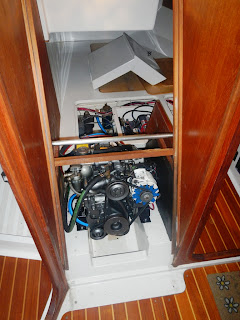Got to the club a little after 10am, John opened the shop for me. Slight change of plans: next weekend they will have a 170 ton crane in to move a couple of boats around, put the recently completed dock 6 sections in the water, and launch the work barge. We will use the crane to lift the boat off the cradle using proper spreaders and slings, use the hydro truck to set the keel in the cradle, then lower the boat on the keel/cradle.
I used the handheld grinder to fair the keel for about an hour; looking pretty good.
Also used a random orbit disk sander. Then washed the keel with a degreaser, and rinsed it with some fresh water I brought in a 5 gal plastic bucket. I then coated the keel in an autobody rust prep (basically phosphoric acid). It was brushed on, making sure to get in to all the crevices. It took about two hours to dry, so I went onto removing all the 5200 sealant on the keel stub.
 |
| In places it is 3/8" thick |
Also took some 1/2" and 5/8" drills and reamed out the holes to accomodate the new studs:
It was slow going removing the old bedding using a wood chisel and hammer:
Back to the keel: when the acid wash was dry, I rinsed the entire keel in fresh water.
 |
| The rust prep turns any rust into a grey oxide that paint adhers to |
 |
| Keel is very pitted on the one side |
 |
| Closer look |
Back to the keel stub:
 |
| Here it is completed before sanding |
This exposed the fibreglass laminate on the bottom of the keel stub.
I did not get a completed photo after sanding.
Time to paint the prepared keel with the POR-15 paint I had bought online. Normally, you can open a paint can with a screw driver in about 3 seconds. Something is wrong with the paint can: could not open it! The lip of the lid just folded up, even tried gripping it with vice grips! The lid is sealed to the can:
I had purposely bought this online from the Canadian distributor in Grimsby, because the product is not available at local retailers. Kinda euchred!
So, I went to Martin's (Port Whitby Marine) to get some epoxy fairing material, and low and behold, they stocked POR-15! Went to pay for it and some epoxy fairing, but didn't have my wallet; tore the car apart; could not find it anywhere! Grrrr...
Went back to the club thinking I left it in the shop; was not there. Tried to open the can for another half an hour; no dice. This is really screwing me!
Went back to the boat and sanded the bottom for a couple hours. This operation is going to take a lot longer than I thought; only got perhaps 5% of the hull sanded.
When I was cleaning up afterwards, I found my wallet in the grass underneath the cradle; it must have fallen out of my jean jacket pocket when working under the boat. Glad I found it.
WHAT A FRUSTRATING DAY!
What should have taken 3 seconds took several hours, and the keel is not painted.
Have to work after work a bunch this week to get ready for the crane on Saturday. The keel needs to be painted, 1/2" studs added, the shrink wrap removed, and the cradle leveled.
Got the following response from the company this morning:
Sorry for the inconvenience of the situation , if you mail the can back I will refund the amount of your order and the return shipping .
The factory uses an interference lid for shipping purposes and every once in a while this occurs .
Thanks
Stevens Auto Electric & Machine Ltd.
In the meantime... I'm cleaning my gun.
Mark Knopfler --- Get Lucky Album 2009








































